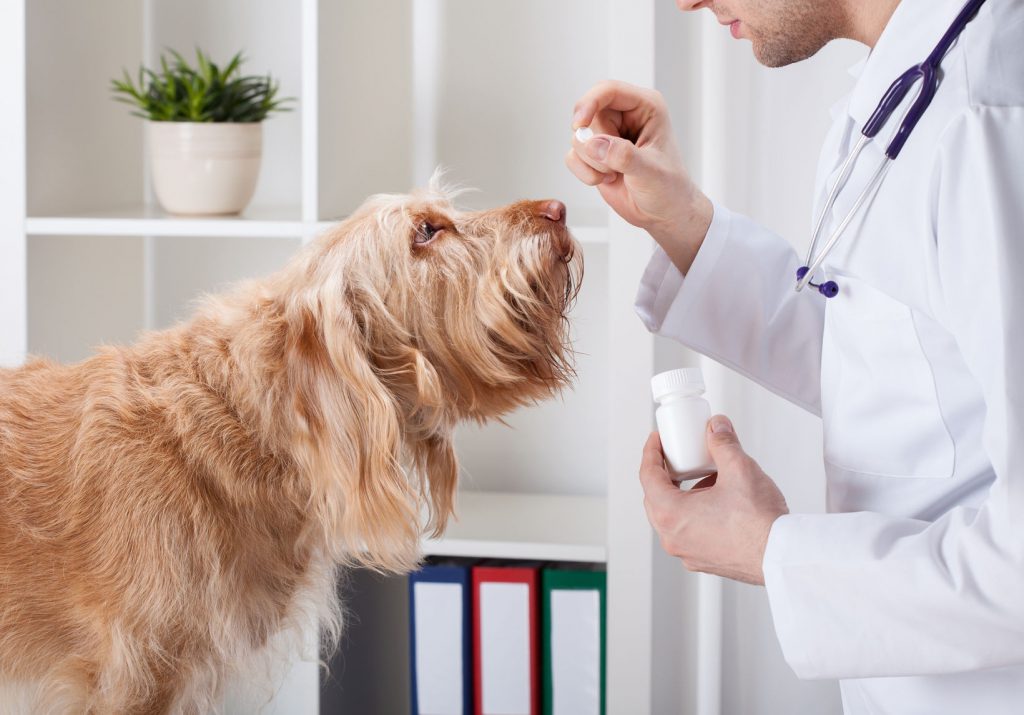Some people believe they couldn’t put a price on the love of their pet, but the American Pet Products Association (APPA) isn’t shying away from reporting a number. According to the not-for-profit trade association, US dog owners spent over $60 billion on their pets in 2015.
While pet food makes up the majority of expenses at $23.05 billion, over-the-counter (OTC) medicines and veterinary care combined total $29.7 billion. Despite pet owners’ obvious willingness to invest in their pet’s health, it’s been estimated that over 90 percent of medicines prescribed to pets are just human-approved drugs being given to animals off-label.
“That figure (90%) is an estimate which is difficult to validate and may be a bit high,” Dr. Thomas Vickroy, professor at the University of Florida, College of Veterinary Medicine told Xtalks. “Nevertheless, the central point is correct in that many medications, both prescription and over-the-counter, are used in companion animals and other non-human species even though these products are labeled and approved exclusively for human use.”
Like Vickroy, other veterinarians believe this statistic could be inflated. “There are a number of medicines that have been developed specifically for veterinary patients,” Dr. Cheryl London, Director of the Clinical Trials Office at Cummings School of Veterinary Medicine at Tufts University, and the College of Veterinary Medicine at Ohio State University told Xtalks. “There are certain things that we certainly use that are human drugs; many of the antibiotics that we use are generic. We use many of the blood pressure medications, and many of the chemotherapeutics we use are generic.”
To address this potentially unmet need in the pet health sector, biotech companies focused on developing drugs for companion animals have been popping up in recent years. Zoetis, Kane Biotech, Aratana Therapeutics and Nexvet are just some of the biotechs working towards better medicines, vaccines and diagnostics for cats and dogs.
“Some small companies spring up around a single novel treatment for a disease or disorder that represents an unmet need in the veterinary market,” said Vickroy. “One thing is for certain and that is that a growing number of people consider their pets to be members of the family and, as such, they are willing to spend significant amounts of money on the care and welfare of their furry friends.”
Ability to skip preclinical studies in animals
There are many advantages to developing novel therapeutics – or modifying drugs already approved for human use – for the pet health market. Biotech companies are not required to conduct preclinical animal studies for a drug candidate, but instead are able to go directly into testing involving the species of companion animal for which the therapeutic is being developed.
This not only significantly speeds up development time, but also reduces the investment needed to get a new drug to market. For example, Aratana Therapeutics received US Food and Drug Administration (FDA) approval for three biopharmaceutical products in 2016. In comparison, only 15 biologic drugs from all biotech companies were approved by the FDA for human use last year.
Regulations are less cumbersome compared to humans
While the pet health sector is still stringently regulated, it is less so compared to drugs designed for human use. In the US, the United States Department of Agriculture (USDA) regulates vaccines and other biologics, while the FDA regulates small molecule drugs and other pharmaceuticals for pets.
“They have a specific set of regulations that need to be followed and a specific set of endpoints and milestones that need to be met and regulatory guidelines for approving those sorts of things,” said London. “The regulatory framework isn’t as cumbersome as it is on the human side, but it still exists.”
Faster approval process
According to the Federal Food, Drug, and Cosmetic Act (FFDCA), the FDA approves and regulates new animal drugs through its Center for Veterinary Medicine (CVM). Once a drug developer has identified a promising new compound, and small pilot studies show that it could be effective in the target animal species, the drugmaker must begin the process of opening an Investigational New Animal Drug File with the Office of New Animal Drug Evaluation (ONADE).
Much like an investigational drug designed for human use, animal drugs must have a clearly defined dosage regimen. This encompasses all aspects of using the drug in practice, including the recommended dose, frequency, duration and route of administration of treatment.
Before the biopharmaceutical company can submit a New Animal Drug Application (NADA), they must collect data on the safety, effectiveness, manufacturing controls and environmental impact of the drug.
For pet products, a new chemical entity can be brought to market in just six years, at an average cost of less than $10 million. Human drugs take more than twice as long to gain approval, at which point the average biopharmaceutical company has invested around $2 billion into the biologic.
Opportunity to license abandoned drugs for veterinary use
Dogs are sometimes used as animal subjects in preclinical research, to judge a new drug’s safety and efficacy in a closely-related species before subjecting human patients to the compound. Though many drugs are abandoned in early human clinical trials due to a drug’s failure to meet primary endpoints, they may have shown promising results in early animal tests.
“For some but not all diseases, dogs and cats serve as very effective models for predicting treatment efficacy in humans,” said Vickroy. “Certain forms of cancer exhibit remarkable correlations between dogs and humans and because dogs have much shorter life expectancies than humans, the progression of the disease as well as the ability of drugs or other treatments to cause remission all occur on shorter timelines.”
This opens the doors for pet biotechs who specialize in commercializing biologics for veterinary medicine previously developed by other drug companies. In April of this year, veterinary cancer therapeutics company VetDC announced that their small molecule lymphoma drug Tanovea received conditional approval from the FDA.
The drug was originally developed by Gilead for use in human patients but the company abandoned development of the compound after it was associated with adverse events. VetDC licensed the drug from Gilead in 2011 with the aim of testing its safety and efficacy in canine lymphoma patients.
Growing number of pet clinical trials
A quick search of the American Veterinary Medical Association’s Animal Health Studies Database identified 279 clinical trials testing medicines in pets in various stages of development. Like human clinical trials, the companion animal-focused studies cover a range of conditions, including cancer, sepsis and atopic dermatitis.
The majority of studies which were listed as currently recruiting at the time of this writing were focused on testing cancer therapies in cats and dogs. In the US, cancer represents the leading cause of death for dogs, with an incidence of 47 percent. Cats have slightly fewer reported cases of cancer-related death at 32 percent.
Similarly to human clinical trials that can struggle to recruit and retain the right patients in the study, finding pet patients can be challenging for veterinary clinical trial coordinators. Since animal clinical trials are most often conducted at large clinics associated with vet schools, animal doctors must get the word out to pet owners at local practices.
“The biggest hurdle is often recruitment of sufficient numbers of patients with the disease or disorder that is the target for drug treatment,” said Vickroy. “For example, if a company wishes to test a new drug for treatment of epilepsy (seizures) in dogs, one of the most significant challenges will come from having enough dogs with treatable seizures in order to test the new drug, since the incidence of epilepsy is relatively low in many breeds of dogs. An additional complication comes from the fact that the incidence of epilepsy is much lower in some dog breeds vs. other breeds and the disease is much more responsive to drug treatment in some breeds vs. others.”
Clinical trials performed in domestic pets can also provide a more accurate picture of how a drug might function in human patients, compared to commonly used rodent models. Since getting approval to conduct preclinical research in larger mammals like cats and dogs is harder than mice and rats, and the availability of disease-specific rodent models continues to increase, these small animals are more often the choice for lab testing.
When biotech companies conduct clinical trials in dogs and cats – whose owners have consented to the study – the results could help another drugmaker develop the compound for use in human patients. In this way, the studies have the chance of helping both the domestic animals and human patients with a given disease.
“We do quite a lot of work in our veterinary patients with natural disease, looking at novel therapies that would have applicability to both our patients as well as human patients,” said London. “It’s not uncommon for us to engage in what we call ‘translational efforts.’ “We’ve worked closely to help define the biology of many of the diseases that we see in our veterinary patients, to see how closely they align with companion human disease, and whether or not we can actually learn something in our veterinary patients and then apply that to human patients.”
Despite the great strides made in drug development for man’s best friend, this clinical research area still faces a few hurdles – one of the largest being a lack of public funding. But for those few companies succeeding in developing drugs and therapeutics for pets, this area has the potential to very rewarding.
What’s your opinion of companies that focus on developing drugs for companion animals? Share your thoughts in the comments section below!











Join or login to leave a comment
JOIN LOGIN